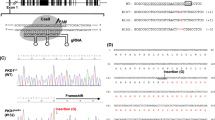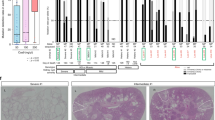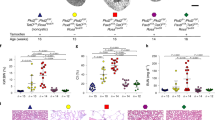Abstract
PKD1 is the most common site for mutations in human autosomal dominant polycystic kidney disease (ADPKD). ADPKD is characterized by progressive replacement of kidney tissue by epithelial cysts and eventual renal failure. Hepatic and pancreatic cysts are also common1. The PKD1 protein, poly cyst in, is a cell-surface protein2,3 of unknown function that is widely expressed in epithelia and in vascular smooth muscle and myocardium4–9. None of the genetic forms of murine polycystic disease map to the murine Pkd1 locus. We introduced into mice by homologous recombination a Pkd1 truncation mutation, Pkd1−, that mimics a mutation found in ADPKD. Pkd1− heterozygotes have no discernible phenotype, whereas homozygotes die during the perinatal period with massively enlarged cystic kidneys, pancreatic ductal cysts and pulmonary hypoplasia. Renal cyst formation begins at embryonic day 15.5 (E15.5) in proximal tubules and progresses rapidly to replace the entire renal parenchyma. The timing of cyst formation indicates that full-length polycystin is required for normal morphogenesis during elongation and maturation of tubular structures in the kidney and pancreas.
This is a preview of subscription content, access via your institution
Access options
Subscribe to this journal
Receive 12 print issues and online access
$209.00 per year
only $17.42 per issue
Buy this article
- Purchase on Springer Link
- Instant access to full article PDF
Prices may be subject to local taxes which are calculated during checkout
Similar content being viewed by others
References
Gabow, P.A. Autosomal dominant polycystic kidney disease. N. Engl. J. Med. 329, 332–342 (1993).
International PKD Consortium. Polycystic kidney disease: the complete structure of the PKD1 gene and its protein. Cell 81, 289–298 (1995).
Hughes, J. et al. The polycystic kidney disease 1 (PKD1) gene encodes a novel protein with multiple cell recognition domains. Nature Genet. 10, 151–160 (1995).
Geng, L. et al. Identification and localization of polycystin, the PKD1 gene product. J. Clin. Invest. 98, 2674–2682 (1996).
Geng, L. et al. Distribution and developmentally regulated expression of murine polycystin. Am. J. Physiol. 272, F451–F459 (1997).
Ward, C.J. et al. Polycystin, the polycystic kidney disease 1 protein, is expressed by epithelial cells in fetal, adult, and polycystic kidney. Proc. Natl. Acad. Sci. USA 93, 1524–1528 (1996).
Griffin, M.D., Torres, V.E., Grande, J.P. & Kumar, R. Immunolocalization of polycystin in human tissues and cultured cells. Proc. Assoc. Am. Physicians 108, 185–197 (1996).
Peters, D.J. et al. Adult, fetal, and polycystic kidney expression of polycystin, the polycystic kidney disease–1 gene product. Lab. Invest. 75, 221–230 (1996).
Palsson, R. et al. Characterization and cell distribution of polycystin, the product of autosomal dominant polycystic kidney disease gene 1. Mol. Med. 2, 702–711 (1996).
Peral, B. et al. Screening the 3′ region of the polycystic kidney disease 1 (PKD1) gene reveals six novel mutations. Am. J. Hum. Genet. 58, 86–96 (1996).
Geng, L. et al. Gene structure, sequence, and a point mutation in the PKD1 gene, and search for point mutations. J. Am. Soc. Nephrol. 5, 622 (1994).
Sorokin, L. & Ekblom, P. Development of tubular and glomerular cells of the kidney. Kidney Int. 41, 657–664 (1992).
Madsen, O.D. et al. Pancreatic development and maturation of the islet B cell: studies of pluripotent islet cultures. Eur. J. Biochem. 242, 435–445 (1996).
Reeders, S.T. Multilocus polycystic disease. Nature Genet. 1, 235–237 (1992).
Qian, F., Watnick, T.J., Onuchic, L.F. & Germino, G.G. The molecular basis of focal cyst formation in human autosomal dominant polycystic kidney disease type I. Cell 87, 979–987 (1996).
Brasier, J.L. & Henske, E.P. Loss of the polycystic kidney disease (PKD1) region of chromosome 16p13 in renal cyst cells supports a loss-of-function model for cyst pathogenesis. J. Clin. Invest. 99, 194–199 (1997).
Author information
Authors and Affiliations
Corresponding author
Rights and permissions
About this article
Cite this article
Lu, W., Peissel, B., Babakhanlou, H. et al. Perinatal lethality with kidney and pancreas defects in mice with a targetted Pkd1 mutation. Nat Genet 17, 179–181 (1997). https://doi.org/10.1038/ng1097-179
Received:
Accepted:
Issue Date:
DOI: https://doi.org/10.1038/ng1097-179
This article is cited by
-
Fibrocystin/Polyductin releases a C-terminal fragment that translocates into mitochondria and suppresses cystogenesis
Nature Communications (2023)
-
Generation of heterozygous PKD1 mutant pigs exhibiting early-onset renal cyst formation
Laboratory Investigation (2022)
-
Loss of the ciliary protein Chibby1 in mice leads to exocrine pancreatic degeneration and pancreatitis
Scientific Reports (2021)
-
Monkeys mutant for PKD1 recapitulate human autosomal dominant polycystic kidney disease
Nature Communications (2019)
-
Ciliary exclusion of Polycystin-2 promotes kidney cystogenesis in an autosomal dominant polycystic kidney disease model
Nature Communications (2019)



